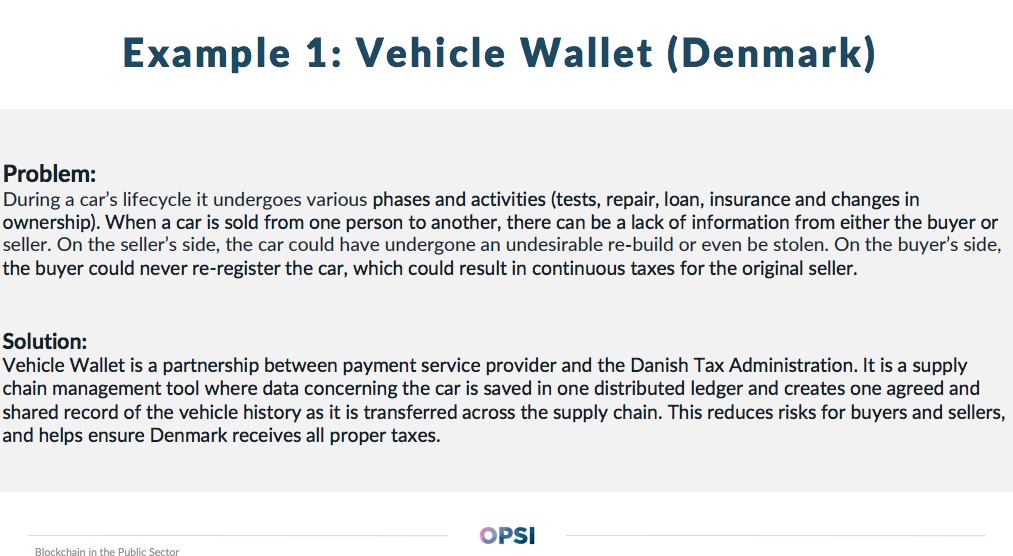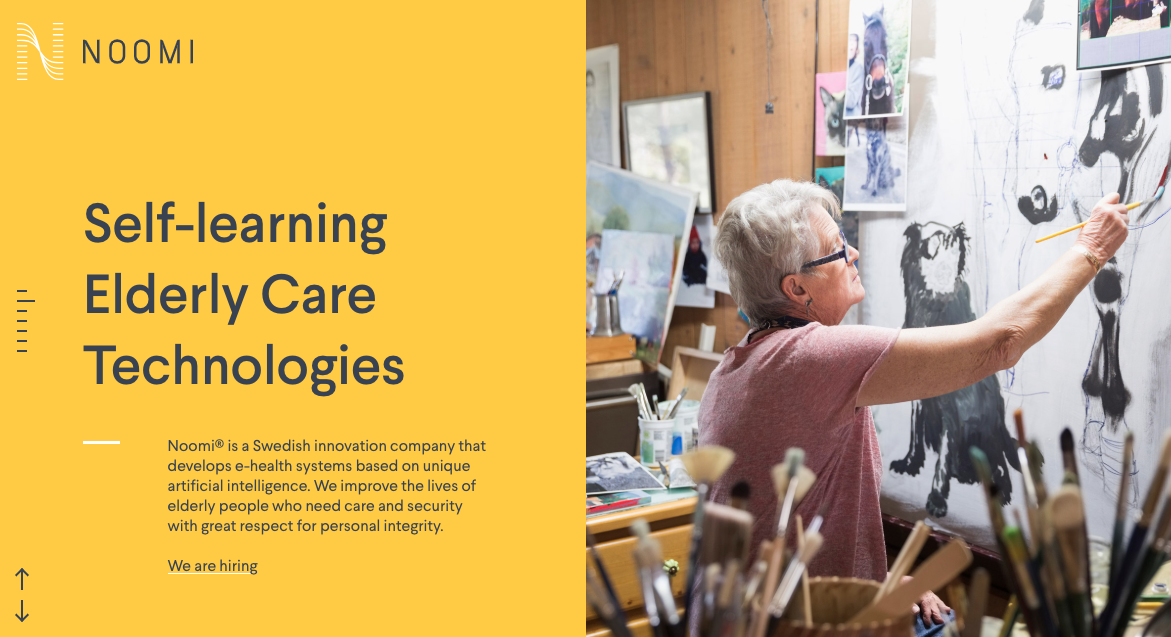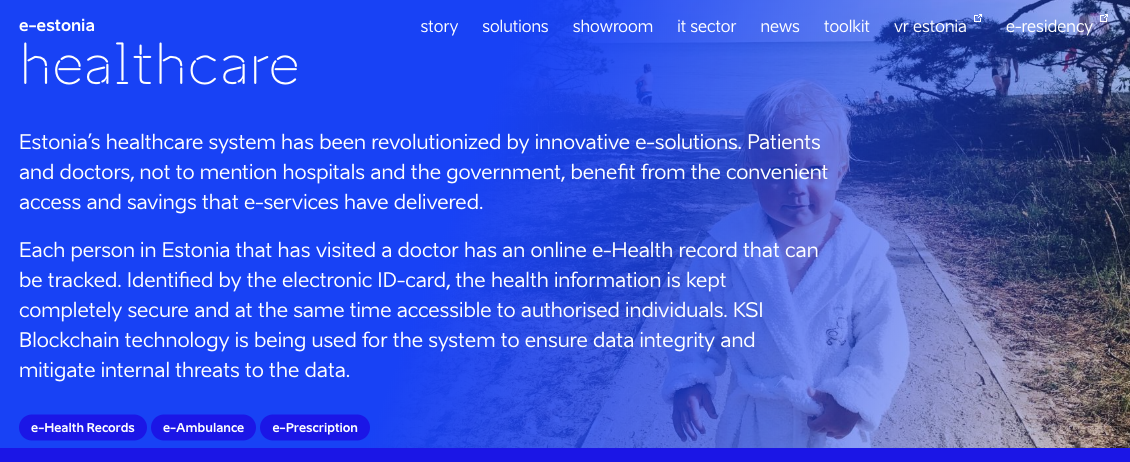
Governments in advanced countries are adopting Blockchain technology and artificial intelligence at a rapid pace. From Estonia, to Malta, The Netherlands to the United States, all countries busy themselves to become fully digitalised societies, hopefully before the expiration of the current decade.In the second part of this article, I examine what is happening in Denmark, Sweden and Estonia.
Blockchain and AI in Denmark
Denmark has been very progressive in its push towards mainstream adoption of the blockchain and AI in governmental function. Several initiatives have been launched to make this a reality in the country. These initiatives are as follows:
- The publication of the Digital Strategy for the years 2016-2020. This document, titled “A Stronger and More Secure Digital Denmark”, identifies three goals that will serve as the template on which the Danish government would kick-start AI and blockchain-based initiatives. These goals are: providing an enabling environment for growth of the sector, enable the development of high quality digital solutions that are user-friendly, and to make security and confidence in the AI-based systems a priority.
- The establishment of DCKAI: the Danish Centre for Artificial Intelligence, which is one of the strategies that was identified as central to the full-scale adoption of AI in Danish government business. This strategy was defined in the “Towards a Digital Growth Strategy – MADE,” document published by the Danish government in October 2017.
- Finally, the launch in January 2018 of the “Strategy for Denmark’s Digital Growth,” which makes AI the central focus of further digital and tech advances.
The government of Denmark is looking into the use of AI and the blockchain in digital identity, healthcare, business support and its welfare system. Denmark is one of those countries which have ensured that most of its service provision to citizens is done digitally. Indeed, 90% of Denmark’s governmental services are already being done digitally (Basu, 2017). But the people want more. Danish citizens are demanding even faster response and delivery times for government services.
Denmark is also being forced into the blockchain evolution by the country’s population demographics. Denmark’s ageing population means that fewer younger people are available to get into the public service. Therefore, this is a classical case where augmentation of the human workforce using the blockchain and AI is desirable. For Denmark, this has become a necessity, even though it can be quite controversial.
Denmark has a welfare system which caters to retirees, vulnerable groups and pensioners. Denmark has an extremely high welfare expenditure profile. Indeed, according to the OECD Social Expenditure Database, Denmark ranks 4th (after France, Finland and Belgium) in terms of % of its Gross Domestic Product (GDP) that goes into social spending (Carlstrom, 2016). This figure is put at just above 30% of GDP. While this may have translated into a high ranking in the OECD Better Life Index, it creates new challenges that need to be addressed. Birth rates have slowed, creating an increasingly elderly population that will require social benefits, without a corresponding number of young people who can work in government to carry out all the paperwork required in processing the welfare benefits. It has become necessary to adopt new technologies to deal with the increased data workload. The use of AI and robots to automate the process and also to augment the existing workforce is a strategy that the government of Denmark is using to ensure every Krone spent on welfare goes a lot further than existing systems will allow.
In healthcare, Denmark is exploring the use of AI and the blockchain to introduce some positive changes to how it administers care to elderly patients, patients with chronic health conditions as well as patients with mental health issues. According to Lars Frelle-Peterson, the Director-General of the Danish Agency for Digitization, the Danish government is interested in using AI to assist doctors and nurses in their decision-making processes as they administer care to patients, as well as help them describe treatments and better understand diseases.
Frelle also highlights the positives of using AI in managing patients with mental health issues where mobility can be a problem. There is now a system in place where patients who are chronically ill or have mental health issues can be treated at home, using remote systems that connect them with their healthcare providers. This has the benefit of cutting the costs of providing health to these populations and will also have the added benefit of providing greater patient satisfaction.
Education is another area where AI and the blockchain are expected to be used as tools of intervention. Starting in 2019, a new digital learning platform that is expected to connect all schools in the country, will be launched. This new system will enable parents to keep track of the progress of their children and will also host an app store that will be able to warehouse various e-learning tools (Chin, 2017).
If there is any country which has been very progressive in the adoption of AI and blockchain technology, it is Denmark. A practical example of what is being done in Denmark we have its recent initiative of the vehicle wallet.
Denmark’s Vehicle Wallet
The vehicle wallet results from a public private partnership, between payment service provider and the Danish Tax Administration, where Blockchain-based innovation is used to co-create a proof of concept on a registered digital asset management for handling a vehicle’s life cycle process.
All data concerning the car throughout its life cycle (tests, repair, loan, insurance and changes in ownership) is saved in one distributed ledger and creates one agreed and shared record of the vehicle history as it is transferred across the supply chain. The goal of the vehicle wallet is then to reduce risks for buyers and sellers, and to ensure that Danish Government receives all proper taxes.

Blockchain and AI in Sweden
We move to a country next door to Denmark, to see if it is keeping pace with developments in the blockchain and AI space. Not to be left behind, Sweden has made the development of blockchain and AI-based technology a priority. Just like Denmark, Sweden also boasts of a highly digitalized economy, and the government wants AI and Blockchain to become part of mainstream government function. However, Sweden has a skills deficit in this area. So a concern for the Swedish government is how to bridge the AI and blockchain skills deficit, as it moves towards adoption of these technologies.
However, some authorities in the digital space have expressed dissatisfaction at what they deem to be the slow pace with which the government is moving. Danica Kragic Jensfelt, a prominent expert on artificial intelligence and Professor of Robotics at Stockholm’s Royal Institute of Technology (KTH), opined in an interview with a local newspaper, that the Swedish government was not keeping pace with the rapid development of the industry in terms of spending and initiatives.
Be that as it may, several initiatives are being tested by the Swedish government to see how well they can incorporate AI and the blockchain. Vinnova, Sweden’s innovation agency, which was set up by the Swedish government in 2001, was recently tasked with assessing how AI was being utilized across the country and indeed, the perception of the technology itself. Their findings were captured in a report released in December 2017, entitled “Artificial intelligence in Swedish business and society” which among other things, articulated the various initiatives that AI could be used to achieve. Some of the most important areas of application for AI identified by the report, as being of particular importance to Swedish business and society, were the following:
- Industrial development – development of products and services and manufacturing and service processes
- Travel and transports – autonomous vehicles, logistics and transport infrastructure The net effects of labour dynamics for the economy are largely very uncertain. Based on historical development and new scenarios, there is no reason to assume, however, that the creation of new jobs will be slower overall than the pace of the jobs that will disappear.
- Sustainable and smart cities – transport systems, energy and waste, education and healthcare systems
- Health – products, services and processes for diagnostics, drugs, and healthcare
- Financial services – service development in finance, insurance and payment systems
- Security – defence, civil contingency, police and customs
An interesting example provided in Vinnova’s research was about Aifloo SmartBand – “a self-taught e-health system for home care” developed by startup Aifloo (now called Noomi) in cooperation with Skellefteå Municipality.The bracelets developed in the partnership alert the health services if something goes wrong, which provides older people with the possibility of maintaining their independence. The bracelet is carried by recipients of home care services, and it monitors where the bearer is located and how they move. If anything unforeseen happens, such as a fall, the system sends an alarm. The bracelet is combined with a cloud-based AI engine that enables a smart movement analyses. It has also other functionalities, such as whether the bearer has woken up and gotten out of bed, and if the person is eating or taking their medicine.

An official document detailing the Swedish government’s AI implementation strategy was released in May 2018. The “National Approach for Artificial Intelligence” would detail how the Swedish government would pursue the development of infrastructure to create new AI-based opportunities and would also promote the widespread adoption of AI in a manner that was ethical, safe and sustainable. To this end, several universities in Sweden were selected for pilot funding to train AI professionals in an attempt to bridge the AI and blockchain skills gap that currently exists in the country.
Vinnova’s agency published in 2016, another report outlining Blockchain developments in Sweden. Entitled, “Blockchain, decentralized trust“, the report presented some of the the Blockchain initiatives to date in Sweden, particularly from banks, financial institutions and academia.
Lantmäteriet’s pilot experiment with Blockchain for recording property-related transactions
One of the use areas that are being considered by the Swedish government for deployment of AI and the blockchain is the real estate sector. The Lantmäteriet, which is the government agency in charge of land and property registrations in Sweden, has put blockchain’s promises of transparent and tamper-proof transaction records to the test by implementing a pilot system for recording property-related transactions (Haaramo, 2017).
The concept behind this project is to create a “digital original” of property documents, accessible to all parties in a transaction and which enables conclusion of transactions in record time. The project is homegrown; it was developed by ChromeWay, a Swedish company. To preserve the integrity of the blockchain for this project, access is restricted to banks, real estate agents and other relevant parties to each transaction. One of the main goals of the project is to reach a turnaround time for complete processing of documentation for each transaction has been shortened from an average of 4 months to just a few days (Haaramo, 2017).
In June 2018, Lantmäteriet announced that it had completed the third phase of testing and development of the project, when performing a live demonstration of the platform. They further announced their partners which include financial firms SBAB Bank and Landshypotek, blockchain startup ChromaWay, tech consultancy Kairos Future, real estate search portal Svensk Fastighetsförmedling, telecom Telai Sverige and IT firm Evry.

Blockchain and AI in Estonia
Estonia is a country of about 1.3million people. Though geographically and numerically a small country, Estonia has pioneered some of the greatest digital advances of any country as far as government administrative function is concerned. In 2014, Estonia launched its widely acclaimed e-Residency project, which allows non-Estonia citizens or residents open and operate companies, bank accounts as well as use public and private services that are also available to Estonian citizens/residents.
In Estonia, almost every government department is digitalized: identity management, security services, healthcare, e-governance, mobility services, business, tax administration, finance, education, etc. With such a digitalized structure, the use of the AI and the blockchain within these sectors will serve to boost an already advanced structure of government administration.
One important takeaway from the Estonian example is the pro-activeness of the government in providing policy support for use of new technologies in its functions. Let us examine some of the ways that the Estonian government is deploying AI and the blockchain in various sectors of its economy.
1.Blockchain and Healthcare in Estonia
In 2016, the Estonian government began a nationwide project to deploy the blockchain in order to preserve the healthcare records of its entire population. This project, which was initiated by the Estonian E-health Foundation, is designed to tap into the incorruptible power of distributed ledger technology in order to preserve the activity logs and medical notes on medical records of the Estonian population. Estonia has a nationwide health insurance scheme, offered either by private entities or via the government’s Estonian Health Insurance Fund.
Each person in Estonia that has visited a doctor has an online e-Health record that can be tracked. The e-Health Record retrieves data according to the needed circunstances, from various providers, who may be using different systems, and presents it in a standard format via the e-Patient portal. Identified by the electronic ID-card, the health information is kept safe and at the same time accessible to authorised individuals. KSI Blockchain technology is used for the system to ensure data integrity and mitigate internal threats to the data.

2. Blockchain and Digital Identity Management
Estonia has one of the most advanced digital identity management systems in the world. Digital identity is at the very heart of everyday life in Estonia. Complete adoption of digitalization of identity by all Estonian citizens as well as adoption of its usage in everyday transactions speaks to the level to which significant trust has been built over time between government agencies and citizens. Such a high level of trust in digital methods of identity management is the perfect foundation on which new technologies such as AI and the blockchain can be built. The Estonian government is intent on leveraging on this trust and widespread digital adoption by introducing AI into government services. This represents the next stage of digitization of e-government services in Estonia. To this end, an AI Taskforce has been setup. The AI Taskforce will among other things, formulate a strategy for development, implementation and deployment of artificial intelligence (the so-called Kratt) in the public and private sector.
Estonia citizens and e-residents are issued a cryptographically secure digital ID card powered by blockchain infrastructure on the backend, allowing access to various public services. On a blockchain platform, citizens can verify the integrity of the records held on them in government databases and control who has access to them.
The only challenge that is foreseen in AI deployment in Estonia are the legal hurdles that need to be addressed in case of malfunction of AI-driven systems. Who can be held legally liable for a malfunction of a system that as it were, thinks for itself? How can the controversial attributes of AI be managed? The debate over algorithmic liability still goes on, even as work is ongoing at developing a draft legislation (the Kratt law) to take care of these issues.
Conclusion
In this article in 2 parts I have tried to map what is happening in terms Blockchain and AI Governmental initiatives in a few Western countries. I have provided examples from the US, The Netherlands, Sweden, Denmark and Estonia. These are countries with completely different characteristics, in terms of size and economic power, but all demonstrate considerable interest in experimenting with the possibilities offered by these two disruptive technologies. The examples provided give the reader a small sample of the variety of approaches out there. To conclude it is important also to bear in mind, that the promising technologies of Blockchain and AI also give rise to new challenges, particularly in terms of data ownership and its inherent questions of privacy, ethics and trust. This will be dealt with in another article.

Dinis Guarda is an author, academic, influencer, serial entrepreneur, and leader in 4IR, AI, Fintech, digital transformation, and Blockchain. Dinis has created various companies such as Ztudium tech platform; founder of global digital platform directory openbusinesscouncil.org; digital transformation platform to empower, guide and index cities citiesabc.com and fashion technology platform fashionabc.org. He is also the publisher of intelligenthq.com, hedgethink.com and tradersdna.com. He has been working with the likes of UN / UNITAR, UNESCO, European Space Agency, Davos WEF, Philips, Saxo Bank, Mastercard, Barclays, and governments all over the world.
With over two decades of experience in international business, C-level positions, and digital transformation, Dinis has worked with new tech, cryptocurrencies, driven ICOs, regulation, compliance, and legal international processes, and has created a bank, and been involved in the inception of some of the top 100 digital currencies.
He creates and helps build ventures focused on global growth, 360 digital strategies, sustainable innovation, Blockchain, Fintech, AI and new emerging business models such as ICOs / tokenomics.
Dinis is the founder/CEO of ztudium that manages blocksdna / lifesdna. These products and platforms offer multiple AI P2P, fintech, blockchain, search engine and PaaS solutions in consumer wellness healthcare and life style with a global team of experts and universities.
He is the founder of coinsdna a new swiss regulated, Swiss based, institutional grade token and cryptocurrencies blockchain exchange. He is founder of DragonBloc a blockchain, AI, Fintech fund and co-founder of Freedomee project.
Dinis is the author of various books. He has published different books such “4IR AI Blockchain Fintech IoT Reinventing a Nation”, “How Businesses and Governments can Prosper with Fintech, Blockchain and AI?”, also the bigger case study and book (400 pages) “Blockchain, AI and Crypto Economics – The Next Tsunami?” last the “Tokenomics and ICOs – How to be good at the new digital world of finance / Crypto” was launched in 2018.
Some of the companies Dinis created or has been involved have reached over 1 USD billions in valuation. Dinis has advised and was responsible for some top financial organisations, 100 cryptocurrencies worldwide and Fortune 500 companies.
Dinis is involved as a strategist, board member and advisor with the payments, lifestyle, blockchain reward community app Glance technologies, for whom he built the blockchain messaging / payment / loyalty software Blockimpact, the seminal Hyperloop Transportations project, Kora, and blockchain cybersecurity Privus.
He is listed in various global fintech, blockchain, AI, social media industry top lists as an influencer in position top 10/20 within 100 rankings: such as Top People In Blockchain | Cointelegraph https://top.cointelegraph.com/ and https://cryptoweekly.co/100/ .
Between 2014 and 2015 he was involved in creating a fabbanking.com a digital bank between Asia and Africa as Chief Commercial Officer and Marketing Officer responsible for all legal, tech and business development. Between 2009 and 2010 he was the founder of one of the world first fintech, social trading platforms tradingfloor.com for Saxo Bank.
He is a shareholder of the fintech social money transfer app Moneymailme and math edutech gamification children’s app Gozoa.
He has been a lecturer at Copenhagen Business School, Groupe INSEEC/Monaco University and other leading world universities.




























